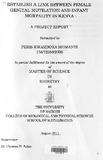| dc.description.abstract | Cesarean section (CS) can be a life-saving technique for both mother and infant. On the other
hand it presents documented medical risks such to both mother and baby, which if anticipated
can be averted or have their impact reduced. Many studies have identified non-progressive
labour, placental problems, breech presentation and fetal distress as the major indications for CS
deliveries which may be difficult to detect or manage in our Kenyan setup especially in the
government health facilities.
In this study, multiple logistic regression was used to analyze variable associated to having CS
deliveries and it was found that education level, number of antenatal visits, multiple pregnancy, wealth
index and possession of health insurance were found to be associated to having CS births. It is however
thought that a mix of demographic and health seeking together with ones obstetrics conditions may lead
to a richer model and may help predict one's chances of having CS birth. More insight is also needed on
the financial implications ofCS births and use of the same in reducing CS rates in Kenya.
These results will benefits benefit stakeholders who intend to further study the CS trends in
Kenya of those seeking to design intervention programs to help reduce the CS prevalence | en |

